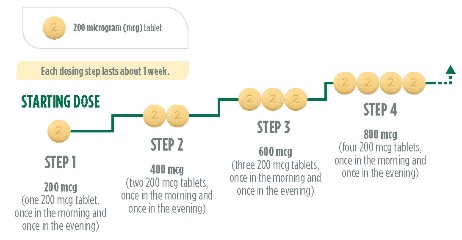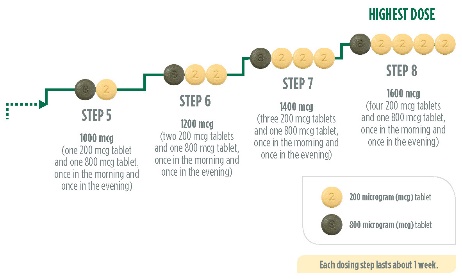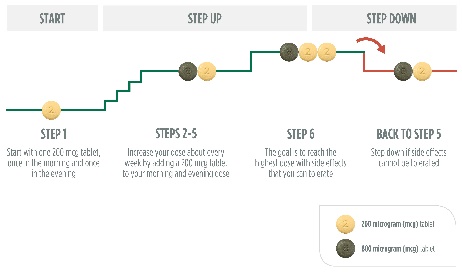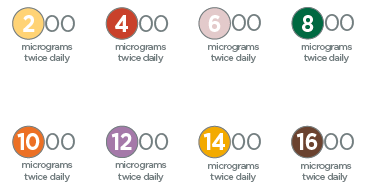UPTRAVI (200727) ACMI
(UP-tra-vee)
Selexipag (se-le-xi-pag) 200, 400, 600, 800, 1000, 1200, 1400, 1600 micrograms film coated tablets
Consumer Medicine Information
What is in this leaflet
This leaflet answers some common questions about UPTRAVI.
It does not contain all the available information.It does not take the place of talking to your doctor or pharmacist.
All medicines have risks and benefits.Your doctor has weighed the risks of you using this medicine against the benefits they expect it will have for you.
If you have any concerns about using this medicine, speak to your doctor or pharmacist.
Keep this leaflet with the medicine.
You may need to read it again.
What UPTRAVI is used for
UPTRAVI contains the active substance selexipag. It is a medicine that acts on a receptor that is the target of a natural substance called “prostacyclin”.
UPTRAVI is used for the long-term treatment of pulmonary arterial hypertension (PAH) in adults.
It can be used on its own or with other medicines for PAH. PAH is high blood pressure in the blood vessels that carry blood from the heart to the lungs (the pulmonary arteries). In people with PAH, these arteries narrow, so the heart has to work harder to pump blood through them. This may cause people to feel tired, dizzy, short of breath, or experience other symptoms.
UPTRAVI widens the pulmonary arteries and reduces their hardening. This makes it easier for the heart to pump blood through the pulmonary arteries.It relieves the symptoms of PAH and improves the course of the disease.
Your doctor however, may prescribe UPTRAVI for another purpose.
Ask your doctor if you have any questions about why it has been prescribed for you.
Before you take UPTRAVI
When you must not take it
Do not take UPTRAVI if:
1.You have ever had an allergic reaction to selexipag or any of the ingredients listed at the end of this leaflet.
Please consult your doctor immediately if you experience any signs or symptoms of a serious allergic reaction:
Wheezing
Swelling of the lips/mouth/throat/face
Difficulty in breathing or tightness in the throat
Hives or rash
fainting
2.You have severe liver problems (Child-Pugh Class C)
3.You have had a stroke within the last 3 months
4.You have severe coronary heart disease or unstable angina
5.You have had a myocardial infarction (heart attack) within the last 6 months
6.You have a weak heart (decompensated cardiac failure) that is not under close medical observation
7.You have severe arrhythmias (irregular heartbeat problem)
8.You have defect of your heart valves (inborn or acquired) that causes the heart to work poorly (not related to pulmonary hypertension)
9.You are taking medicines that are strong inhibitors of CYP2C8 (e.g. gemfibrozil).
UPTRAVI is not recommended during pregnancy and breastfeeding. There is no experience with the use of this medicine during human pregnancy.
Women with PAH should avoid becoming pregnant as your condition may worsen. If you are a woman who can have children, you should use an effective contraceptive method while taking UPTRAVI.
If you are pregnant or breast-feeding, think you may be pregnant, or are planning to have a baby, ask your doctor for advice before taking this medicine
Male fertility – the potential risk for humans is unlikely. Talk to your doctor if you have any questions or concerns about this.
Do not use UPTRAVI after the expiry date [EXP.] printed on the pack.
If you use it after the expiry date has passed, it may not work as well.
Do not use UPTRAVI if the packaging is torn or shows signs of tampering.
If you’re not sure whether you should be using UPTRAVI, talk to your doctor.
Do not use UPTRAVI in children under 18 years of age. There is no experience with the use of this medicine in children or adolescents under 18 years old.
Before you start to take it
You must tell your doctor if:
You are allergic to foods, dyes, preservatives or any other medicines
You are pregnant, trying or become pregnant
You are breastfeeding or planning to breastfeed
You have low blood pressure or experience dizziness or fainting
You have problems with your liver
You are undergoing dialysis
Taking other medicines
Tell your doctor or pharmacist if you are taking any other medicines, including any that you buy without a prescription from your pharmacy, supermarket or health food shop.
Some medicines may affect the way other medicines work.
Your doctor or pharmacist will be able to tell you what to do when using UPTRAVI with other medicines.
You must tell your doctor if you are taking medicines for high blood pressure.
You must tell your doctor if you are taking:
Rifampicin (antibiotic used to treat infections)
Sodium valproate or valproic acid (used to treat epilepsy)
Gemfibrozil (medicine used to lower the levels of fat in the blood)
Lopinavir and ritonavir (antivirals used to treat HIV)
Clopidogrel (used to treat heart disease/strokes)
Deferasirox (used to treat some blood disorders)
Teriflunomide (used to treat nervous system disorders)
How to take UPTRAVI
Always take this medicine exactly as your doctor has told you. Check with your doctor if you are not sure.
How much to take
Your doctor will decide what dose of UPTRAVI is suitable for you.
Take UPTRAVI in the morning and in the evening, consistently either with or without meals.You might tolerate the medicine better when you take it with meals. Swallow the tablets whole, do not split, crush or chew the UPTRAVI tablets.
Tell your doctor if you are taking other medications as your doctor may recommend different dose of UPTRAVI.
Finding the right dose for you
At the start of treatment, you will take the lowest dose. This is one 200 micrograms tablet in the morning and another 200 micrograms tablet in the evening. As instructed by your doctor, you will gradually increase your dose. This is called titration. It lets your body adjust to the new medicine. The goal of titration is to reach the highest dose you can tolerate. This can be up to a maximum dose of 1600 micrograms twice a day.
During titration, you will receive a titration pack containing light yellow UPTRAVI 200 micrograms tablets. These tablets have a “2” stamped on one side. Your doctor will tell you to increase your dose in steps, usually every week. With each step, you will add one 200 micrograms tablet to your morning and evening doses. Below is a diagram to show the dose and the number of tablets at each step for the first 4 steps.

If you reach a dose of 800 micrograms in the morning and 800 micrograms in the evening, your doctor may instruct you to increase your dose to 1000 micrograms in the morning and 1000 micrograms in the evening. This will be done by taking one green 800 micrograms tablet and adding one light-yellow 200 micrograms tablet. For this, you will receive a pack containing green UPTRAVI 800 micrograms tablets (with an “8” stamped on one side) and a titration pack containing light yellow UPTRAVI 200 micrograms tablets (with a “2” stamped on one side).
Your doctor will tell you to increase your dose in steps, usually every week. As before, with each step, you will add a 200 micrograms tablet to your morning and evening doses. The maximum dose of UPTRAVI is 1600 micrograms in the morning and in the evening. However, not every patient will reach this dose.
Below is a diagram to show the dose and the number of tablets at each step starting with step 5.

You will receive a titration guide providing information on how to increase your dose and allowing you to record the number of tablets you take every day. Remember to record the number of tablets you take every day. Remember to talk to your PAH doctor or nurse regularly during titration.
Stepping down to a lower dose due to side effects
During titration, you may experience side effects such as headache, jaw pain, aching joints, muscle pain or a general feeling of being in pain, diarrhoea, feeling sick, being sick, stomach ache or reddening of the face. If these side effects are difficult for you to tolerate, talk to your doctor about how to manage or treat them. There are treatments available that can help relieve the side effects. Do not stop taking UPTRAVI unless your doctor tells you to.
If the side effects cannot be treated or do not gradually get better on the dose you are taking, your doctor may adjust your dose by reducing by one the number of 200 micrograms yellow tablets you take in the morning and in the evening. The diagram below shows stepping down to a lower dose. Do this only if instructed to do so by your doctor.
Do not stop taking UPTRAVI unless your doctor tells you to.

If your side effects are manageable after stepping down your dose, your doctor may decide that you should continue to stay at that level. Please see section “Maintenance dose” below for more information.
Maintenance dose
The highest dose that you can tolerate during titration will become your maintenance dose. Your maintenance dose is the dose you should continue to take on a regular basis, in the morning and in the evening with the minimum side effects.
Every patient with PAH is different. Not everyone will end up on the same maintenance dose. Your maintenance dose will be between 200 micrograms and 1600 micrograms in the morning and in the evening. What is important is that you reach the dose that is most appropriate to treat you.
Your doctor can prescribe an equivalent single-tablet strength for your maintenance dose.
This allows you to take one tablet in the morning and one in the evening, instead of multiple tablets for each.
The single tablet will be of a different colour depending on the dose. Each tablet will have a number on its surface showing the dose (in hundreds of micrograms). For a full description including colours and marking, please see Product Description section of this leaflet.
Over time, your doctor may adjust

your maintenance dose as needed.
If, at any time, after taking the same dose for a long time, you experience side effects that you cannot tolerate or side effects that have an impact on your normal daily activities, contact your doctor.
Do not stop taking UPTRAVI unless your doctor tells you to.
How long to take it
Use UPTRAVI for as long as your doctor advises you to. UPTRAVI is generally used over a prolonged period of time, possibly years. It should not be stopped suddenly.
If you forget to take it
If you forget to take UPTRAVI, take a dose as soon as you remember, then continue to take your tablets at the usual times. If it is nearly time for your next dose (within six hours before you would normally take it) you should skip the missed dose and continue to take your medicine at the usual time. Do not take a double dose to make up for a forgotten tablet.
Do not stop taking UPTRAVI unless your doctor tells you to. If, for any reason, you stop taking UPTRAVI for more than 3 consecutive days (if you missed 3 morning and 3 evening doses or 6 doses in a row or more), contact your doctor immediately as your dose may need to be adjusted to avoid side effects. Your doctor may decide to restart your treatment on a lower dose, gradually increasing to your previous maintenance dose.
If you have any further questions on the use of this medicine, ask your PAH doctor or nurse.
If you take too much (overdose)
Immediately telephone your doctor or the Poisons Information Centre, or go to Accident and Emergency at your nearest hospital, if you think that you or anyone else may have used too much UPTRAVI.Do this even if there are no signs of discomfort or poisoning. Always take the labelled medicine carton with you, even if it is empty.
You may need urgent medical attention. Ask your doctor if you have any concerns.
Poison Information Centre telephone numbers:
Australia: 13 11 26
New Zealand: 0800 POISON or 0800 764 766
While you are using UPTRAVI
Things you must do
Tell your doctor or pharmacist that you are taking UPTRAVI if you are about to start on any new medicines.
Tell your doctor if you become pregnant or are trying to become pregnant.
Tell your doctor if you are breastfeeding or plan to breastfeed.
Tell your doctor if, for any reason, you have not used your medicine exactly as prescribed.
Keep all of your doctor or clinic appointments.
Your doctor may do certain tests, including blood tests, from time to time to make sure the medicine is working and to prevent unwanted side effects.
Things you must not do
UPTRAVI is a treatment that you will need to keep on taking to control your PAH. Do not stop taking UPTRAVI unless you have agreed this with your doctor.
If you have any further questions on the use of UPTRAVI, ask your doctor or pharmacist.
Do not give this medicine to anyone else, even if their symptoms seem similar to yours.
Do not use UPTRAVI to treat any other complaints unless your doctor says to.
Things to be careful of
UPTRAVI can cause side effects such as headaches and low blood pressure and the symptoms of your condition can also make you less fit to drive.
Be careful driving or operating machinery until you know how UPTRAVI affects you. If you are affected, do not drive or operate machinery.
Side effects
Check with your doctor as soon as possible if you have any problems while taking UPTRAVI, even if you do not think the problems are connected with the medicine or are not listed in this leaflet.
Like all medicines, UPTRAVI can cause side effects in some people.
You may experience side effects not only during the titration period when your dose is being increased, but also later after taking the same dose for a long time.
If you experience any of these side effects:
Headache
Jaw pain
Aching joints
Muscle pain or a general feeling of being in pain
Diarrhoea
Feeling sick /being sick
Stomach ache
Reddening of the face
that you cannot tolerate or cannot be treated, you should contact your doctor as the dose you are taking may be too high for you and may need to be reduced.
Very common side effects (may affect more than 1 in 10 people)
Headache
Flushing (reddening of the face)
Nausea and vomiting (feeling sick and being sick)
Diarrhoea
Jaw pain, muscle pain, joint pain
Rash
Stuffy nose
Common side effects (may affect up to 1 in 10 people)
Anaemia (low red blood cell levels)
Hyperthyroidism (overactive thyroid gland)
Decreased appetite
Weight loss
Hypotension (low blood pressure)
Stomach pain
Pain
Changes in some blood test results including those measuring blood cell counts or your thyroid function
Increased heart rate
Eye pain
Fever
Kidney failure (symptoms can include decreased urine output, swelling in the ankles or feet, tiredness, weakness, shortness of breath, confusion or irregular heartbeat)
Burning sensation
Feeling very tired
Flu like symptoms
If you get any side effects, talk to your doctor or pharmacist. This includes any possible side effects not listed in this leaflet.
Do not be alarmed by this list of possible side effects. You may not experience any of them.
This is not a complete list of all possible side-effects. Others may occur in some people and there may be some side-effects not yet known.
Tell your doctor if you notice anything else that is making you feel unwell, even if it is not on this list.
Storing UPTRAVI
Storage
Keep this medicine where young children cannot reach it.
A locked cupboard at least one-and-a half metres above the ground is a good place to store medicines.
Do not leave them in the car or on window sills.
Do not use this medicine after the expiry date which is stated on the carton after EXP. The expiry date refers to the last day of that month.
Store below 30°C. Protect from moisture.
Disposal
Medicines should not be disposed of in wastewater or household waste.
Ask your pharmacist how to dispose of medicines you no longer require. These measures will help to protect the environment.
Product description
What it looks like
UPTRAVI 200 micrograms film-coated tablets are: Round, light yellow, film-coated tablets with “2” marked on one side.
UPTRAVI 400 micrograms film-coated tablets are: Round, red, film-coated tablets with “4” marked on one side.
UPTRAVI 600 micrograms film-coated tablets are: Round, light violet, film-coated tablets with “6” marked on one side.
UPTRAVI 800 micrograms film-coated tablets are: Round, green, film-coated tablets with “8” marked on one side.
UPTRAVI 1000 micrograms film-coated tablets are: Round, orange, film-coated tablets with “10” marked on one side.
UPTRAVI 1200 micrograms film-coated tablets are: Round, dark violet, film-coated tablets with “12” marked on one side.
UPTRAVI 1400 micrograms film-coated tablets are: Round, dark yellow, film-coated tablets with “14” marked on one side.
UPTRAVI 1600 micrograms film-coated tablets are: Round, brown, film-coated tablets with “16” marked on one side.
Pack size
UPTRAVI 200 micrograms film-coated tablets are supplied in blister packs of 10, 60 or 140 tablets.
UPTRAVI 400, 600, 800, 1000, 1200, 1400, and 1600 micrograms film-coated tablets are supplied in blister packs of 60 tablets.
Ingredients
Active ingredient:Selexipag
Each tablet contains 200, 400, 600, 800, 1000, 1200, 1400, or 1600 micrograms of selexipag.
Inactive ingredients:
The other ingredients are:
tablet core:
Mannitol, maize starch, hydroxypropylcellulose, magnesium stearate
film coat:
200 micrograms:
hypromellose, propylene glycol, titanium dioxide (E171), iron oxide yellow (E172), carnauba wax.
400 micrograms:
hypromellose, propylene glycol, titanium dioxide (E171), iron oxide red (E172), carnauba wax.
600 micrograms:
hypromellose, propylene glycol, titanium dioxide (E171), iron oxide red (E172), iron oxide black (E172), carnauba wax.
800 micrograms:
hypromellose, propylene glycol, titanium dioxide (E171), iron oxide yellow (E172), iron oxide black (E172), carnauba wax.
1000 micrograms:
hypromellose, propylene glycol, titanium dioxide (E171), iron oxide red (E172), iron oxide yellow (E172), carnauba wax.
1200 micrograms:
hypromellose, propylene glycol, titanium dioxide (E171), iron oxide black (E172), iron oxide red (E172), carnauba wax.
1400 micrograms:
hypromellose, propylene glycol, titanium dioxide (E171), iron oxide yellow (E172), carnauba wax.
1600 micrograms:
hypromellose, propylene glycol, titanium dioxide (E171), iron oxide black (E172), iron oxide red (E172), iron oxide yellow (E172), carnauba wax.
Sponsor
JANSSEN-CILAG Pty Ltd
1-5 Khartoum Road
Macquarie Park NSW 2113 Australia
Telephone: 1800 226 334
NZ Office: Auckland New Zealand
Telephone: 0800 800 806
This leaflet was prepared in July 2020.
UPTRAVI:
200 micrograms – AUST R 234161
400 micrograms – AUST R 234160
600 micrograms – AUST R 234159
800 micrograms – AUST R 234166
1000 micrograms – AUST R 234162
1200 micrograms – AUST R 234163
1400 micrograms – AUST R 234165
1600 micrograms – AUST R 234164




